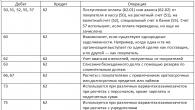Accounting account 62 is the account used to generate transactions for accounting transactions with clients. How to correctly interpret account balances 62? What information can be obtained from the balance sheet and account card? How is VAT accounted for using account 62? In this article we will answer these questions.
Is count 62 active or passive?
Account 62 is included in section VI “Calculations” of the Chart of Accounts. This is a synthetic accounting account. Analytics on account 62 is carried out in relation to each buyer and each contract.
Accounting account 62 is used quite often, since every organization has clients. An accountant needs to regularly monitor client debts in order to timely identify overdue debts. For this purpose, he has the right to open any number of sub-accounts for account 62. The chart of accounts with all subaccounts used must be fixed in the accounting policy.
Standard subaccounts that an accountant works with:
- 01 “Settlements with buyers and customers.”
- 02 “Calculations for advances received.”
- 03 “Bills received.”
In addition to these, you can add a subaccount for retail customers, for settlements in foreign currency, overdue debts, settlements between dependent parties, and so on.
Is count 62 active or passive? As we see from the essence of accounting for transactions on account 62, the balance on it reflects both positive and negative debt, that is, both our debt to customers and their debt to us. Thus, the balance on account 62 can be either a credit or a debit. This means that count 62 is active-passive. In the balance sheet, account 62 should be reflected in detail, that is, the debit balance is in the asset, and the credit balance is in the liability.
Debit shows the debt of counterparties to us
The debit of account 62 shows, as the name suggests, accounts receivable, that is, the amount of debt of counterparties to our organization. If we consider the subaccounts to account 62 of accounting, we can find out details about accounts receivable. For example, the debit of subaccount 62.01 reflects the amounts of shipments made. The debit of subaccount 62.02 shows advances offset against shipments made. The debit of subaccount 62.03 includes bills received on account of shipments made. That is, we see that any debt of the buyer (in the form of goods (work, services) received but not paid for, a bill issued, an offset, previously paid advance) will be reflected in the debit of any subaccount of account 62.
Credit shows our debt
Account credit 62 shows the amount of debt to clients, that is, accounts payable. By analogy, let's turn to the subaccounts to account 62. On the loan, subaccounts 62.01 reflect payment for completed shipments of goods (work, services). Moreover, payment can be made not only in money to a current account or to the cash desk, but also by a bill of exchange or by offset.
The credit of subaccount 62.02 shows advances received against future shipments of goods. The credit of subaccount 62.03 records the amounts received from debtors in payment of bills received from them. That is, similar to the situation with the debit of the account, any debt incurred by our organization to clients (payment by the buyer of his bill or purchased goods) is reflected in the credit of account 62.
Typical transactions for account 62
Postings to account 62 are drawn up in correspondence with the accounts specified in Order of the Ministry of Finance of the Russian Federation dated October 31, 2000 No. 94n.
Examples of debit entries:
Don't know your rights?
Typical loan transactions: 
Organizations that apply the general taxation system and include VAT amounts in the cost of their goods and services charge them to account 62 both upon shipment and upon crediting payment for shipped goods, including advances. Let's consider an example of VAT accounting in the light of the functioning of account 62.
Example
08/01/2018 LLC "Princip" received an advance to the bank account for the upcoming shipment of goods from LLC "Pir" in the amount of 10,000.00 rubles, including VAT 18% - 1525.42 rubles.
The total amount of the contract is RUB 30,000.00, including VAT 18% - RUB 4,576.27.
On August 13, 2018, goods were shipped in the amount of RUB 30,000.00, including VAT 18% - RUB 4,576.27.
On August 15, 2018, Pir LLC transferred 20,000.00 rubles, including VAT 18% - 3,050.85 rubles, to the bank account of Princip LLC as full payment under the contract. The accountant of Principle LLC will make the following entries in the transaction journal. 
What does the balance sheet show for account 62
In order to obtain information on all customer debts and see at the same time all sub-accounts opened for the account, it is necessary to create a balance sheet for account 62. This report helps the accountant assess the overall picture of the state of settlements with clients of the organization. As its name implies, it displays the turnover and balance at the beginning and end of the counterparties for the selected period. The balance sheet discloses information for each counterparty with whom transactions were made for the specified period or at the beginning of which there was an outstanding debt, in the context of each agreement. The balance sheet data is divided into subaccounts.
You will see an example of a balance sheet in our figure. 
How to correctly read a sample account card 62
Account card 62 can be generated for any period of time, for each subaccount separately or as a whole for account 62. The accountant can also make a selection by analytical accounting positions:
- for any counterparty;
- specific contracts.
The account card contains the following items:
- Beginning and ending balances, debit and credit turnovers for the entire account for the selected period. And also the balance at the end of each transaction.
- Date of each transaction.
- Correspondence of accounts and the amount of each transaction.
- Details of primary documents on the basis of which transactions are posted to accounts.
- Names of counterparties and contract numbers.
- The essence of reflected transactions.
Let's look at the sample account card 62 in our picture.
 ***
***
Account 62 refers to active-passive synthetic accounts; it reflects transactions with settlements with clients of the organization. Account analytics is quite detailed and can be built for each agreement within each counterparty. The same applies to subaccounts: the required number of them can be opened for account 62 for more detailed accounting. All added subaccounts must be entered into the Chart of Accounts and approved in the annex to the organization’s accounting policies.
For more detailed coverage of the features of accounting for settlements with buyers and customers, you must refer to the Instructions for using the Chart of Accounts.
Account 62 in accounting is usually debited for the amounts of payment documents presented in correspondence with the credit of accounts 90 “Sales”, 91 “Other income and expenses”, and credited for the amounts of payment received in the debit of accounts 50 “Cash”, 51 “Settlement accounts” and etc.
Analytical accounting for account 62 must be maintained for each invoice presented to customers, and when making payments using scheduled payments - for each buyer and customer. Analytical accounting of settlements with buyers and customers should be organized in such a way that it is possible to obtain data on settlements with such counterparties:
- according to payment documents for which the due date has not yet arrived;
- for settlement documents not paid on time;
- on advances received;
- on bills of exchange for which the due date for receipt of funds has not arrived;
- on bills discounted (discounted) in banks;
- on bills for which funds were not received on time.
Documentation of settlements with buyers and customers depends on the features and procedure for settlements with buyers, whether cash or non-cash payments are made to buyers. As a rule, such documents are invoices, acts, invoices, cash and sales receipts. For example, the rules for paying customers in cash, as a rule, require the issuance of only cash register receipts to them, and when making payments for delivered goods, organizations draw up delivery notes and, if the transaction is subject to VAT, invoices.
In the case of the creation of “doubtful” reserves, the debt of buyers in the balance sheet is reflected minus the created reserve (clause 35 of PBU 4/99).
However, it is impossible to answer unequivocally the question of whether settlements with buyers and customers are an asset or a liability. After all, according to settlements with buyers and customers, both accounts receivable (there is a shipment, but no payment) and accounts payable (when receiving advances) can be formed. In the first case, information on settlements with buyers and customers will be reflected in the balance sheet asset as part of accounts receivable, and in the second - in the liability side as part of short-term liabilities. The above means that accounting account 62 is an active-passive account.
In modern conditions, improving the accounting of settlements with buyers and customers comes down mainly to increasing the efficiency of data on settlements with buyers and speeding up the exchange of documents between counterparties. One of the elements in the development of the system of settlements with customers is the introduction of electronic document management.
Settlements with buyers and customers: postings
In settlements with customers, the main transactions consist of recognizing income from the sale of goods, works or services and receiving payments to repay accounts receivable, as well as advance receipts.
Thus, the following accounting entries are made in the seller’s accounting records for the amounts of the presented settlement documents:
Debit of account 62 - Credit of account 90 “Sales”, 91 “Other income and expenses”The use of accounts 90 and 91 depends on whether the income being recognized is or.
In retail sales, the fact of sale can be recognized bypassing account 62, when the following posting is made: Debit account 50 “Cash” - Credit account 90.
Accounting entries are generated for the amounts of received payments (including advances):
Debit of accounts 50 “Cash”, 51 “Cash accounts”, 52 “Currency accounts”, etc. - Credit of account 62.
In this case, separate accounting of advances is kept on account 62, as a rule, by opening an additional sub-account.
In accounting for settlements with buyers and customers, postings are not limited to records for recording sales and receipt of payment. The procedure for accounting for settlements with buyers and customers requires reliable reflection of information about such settlements in the financial statements. For these purposes, the debt of buyers and customers is analyzed for its doubtfulness and the need to create a reserve in account 63 “Provisions for doubtful debts” at the expense of financial results (clause 70 of Order of the Ministry of Finance dated July 29, 1998 No. 34n):
Debit account 91 “Other income and expenses” - Credit account 63.In accounting, account 62 is used to control This register was created to maintain analytical records of all documentation presented to the customer, as well as to control incoming payments.
An accountant working with account 62 reflects as completely as possible all data about the buyer in the register. This approach allows you to quickly analyze:
- terms of payment under the contract;
- control overdue payments on issued certificates;
- accumulate advances received towards future services;
- keep track of bills that are not due for payment;
- control overdue bill receipts.
There is no provision for dividing account 62 into subaccounts in the chart of accounts, so the accountant independently applies analytics that are convenient for a particular organization. This division is necessarily reflected in the company's accounting policies.
Retail can use account. 62 without analytics
Maintaining 62 accounts without breaking them down into subaccounts is convenient for companies engaged in retail trade and receiving payment for goods in cash through a cash register. In retail, they are not interested in the buyer’s data and do not draw up long-term contracts with him. Most often, all buyers end up in a single sub-account called “Private Individual”.
Retail companies engaged in selling things in installments, on terms of lending to citizens (not banks), often face the problem of difficult tracking of loan repayments. Chain stores that sell expensive household appliances mainly find themselves in this situation. There is also a need for tracking in case of prepayment for goods. Therefore, it would be more appropriate to maintain sub-accounts for such clients.
It is worth noting that maintaining an account linked to certain sellers or managers can help in the fight against theft and monitor the correct execution of the order. The invoice will clearly demonstrate which material person made a miscalculation when shipping or paying for the goods.
The need for subaccounts in wholesale trade

In wholesale and non-cash trade the situation is different. 62 the account is maintained for each counterparty agreement. This is especially important when customers enter into several contracts with different conditions and terms.
Using subaccounts results in rather labor-intensive accounting. 62 account is overgrown with nomenclature, but such work is justified, as it makes accounting convenient and reliable. Such reporting is also convenient in case tax authorities have questions. Maximum transparency of calculations is always encouraged.
Account 62: postings
All fulfilled obligations with clients are always debited to sales accounts 90.1) and credited in correspondence with cash receipts (dt 51, set 62.1). Such postings are basic. The amounts of advances received are accounted for in separate subaccounts (kt 51, kt 62.2).
If the calculation is ensured by an interest-bearing bill, then as payments are received it is debited and the interest goes to other income and expenses (account 91).
Using 62 accounts when working with branches

In the case where an organization has separate divisions and draws up a consolidated balance sheet, accounting for settlements and obligations with customers and purchasers is kept separately.
If the parent organization carries out all payments for it, then invoices must be used in the transactions. 79. For example, funds for the sale of goods and services are debited to the “Internal business settlements” account, and credited to account 62 (dt. 79, dt. 62). Branches are also required to introduce subaccounts similar to the parent company for more convenient balance consolidation.
In this article we will look at how relationships with customers are taken into account in accounting. Which account is used to record customers, what postings are made. Transactions during a regular sale, upon receipt of an advance from a buyer or a bill of exchange are considered.
To account for settlements with buyers, account 62 “Settlements with buyers” is used, the debit of which reflects the buyer’s debt to the seller, and the credit reflects payment for goods, work, and services.
Buyers can pay the seller either after receiving the goods, or by making an advance payment, that is, by transferring the advance to the seller’s bank account. Payment by the buyer for the goods is made on the basis of an issued invoice, a sample of which can be viewed.
Accounting for settlements with customers during sales
Revenue from the sale of goods (work, services) is recognized as income from an ordinary type of activity and is reflected in the credit of account 90 “Sales”.
If the sale is one-time and is not a regular activity of the enterprise (for example, the sale of a fixed asset), then the proceeds are reflected as part of other income under the credit of account 91 “Other income and expenses”.
These two accounts 90 and 91 will be discussed in detail a little later; they are interesting and unlike other accounts, they have their own characteristics. It is necessary to calculate VAT on the sale price of goods (works, services) and send it for payment.
Postings to account 62 during normal sales:
Debit | Credit | Operation name |
Revenue from the sale of goods (works, services) is reflected |
||
VAT accrued on goods sold (work, services) |
||
Revenue from the sale of fixed assets, intangible assets, materials is reflected |
||
VAT accrued on sold assets |
||
Payment received from buyer |
Accounting for advances received in settlements with customers
If the buyer pays for the goods in advance and makes an advance payment, then to account for settlements with buyers, in this case, subaccount 2 “advance received” is opened on account 62, while subaccount 1 will reflect settlements with buyers in the general case.
Postings for accounting for advances received (account 62)
Debit | Credit | Operation name |
62. Advance received | An advance was received from the buyer to the bank account |
|
76.VAT on advances received | VAT is charged on the advance received |
|
Revenue from sales of goods is reflected |
||
VAT accrued on goods sold |
||
62. Advance received | Offset of advance against debt repayment |
|
76.VAT on advances received | Accepted for deduction of VAT in connection with the sale of goods paid in advance |
Accounting for bills received from the buyer:
If the buyer issued a promissory note to the seller, it must be accounted for in subaccount 3 “Bill of note received” of account 62. After the sale of the product, posting D51 K62. Bill of exchange received - this bill is repaid.
If the nominal value of a bill of exchange received exceeds the sale price, then the excess amount is reflected in entry D62. Bill of exchange received K 90/1.
Postings to account 62 when paying by bill of exchange:
Count 62 in infographic. Typical wiring
The figure below shows the main transactions of account 62 “Settlements with buyers and customers”.

Typical transactions for account 62
An example of accounting for settlements with buyers and customers. Postings
In fact, account 62 “Settlements with buyers” reflects the buyer’s debt to the seller, that is, accounts receivable. Postings to account 62 are made at the time the sale is made, that is, at the time.
Thus, account 62 reflects settlements with customers and 3 sub-accounts can be opened on it:
- subaccount 1 – to reflect settlements for regular sales;
- subaccount 2 – to account for the advance received;
- subaccount 3 – for accounting for bills received.
In the next article we will look at how to carry out accounting of accounts payable: ““.
Video lesson “Settlements with buyers and customers. Count 62"
In this video lesson, accounting account 62 “Settlements with buyers and customers” is discussed, standard transactions and examples are discussed. The lesson is taught by chief accountant N.V. Gandeva. (teacher, expert of the site “Accounting for Dummies”). Click to watch video ⇓
Accounting account 62 is a special analytical account that is used to reflect the supplier’s transactions with the buyer and customer. This article will give you an idea of the main transactions on account 62, which is reflected in the debit and credit of account 62, as well as the documents that are the basis for their implementation.
Account 62 - can reflect both our debt to the buyer (credit) and the buyer's debt (debit). Therefore, this account is considered active-passive - it can be included in the balance sheet as a Liability or an Asset.
Under loan 62, the account receives funds from, as well as prepayment amounts for goods and services. In this case, payments for services rendered and advances are taken into account in different subaccounts:
- Invoice – payment received in accordance with the general procedure;
- Check - .
In addition, there is a sub-account for separate accounting of bills received (). If the supplier receives a bill of exchange from the buyer providing for the payment of interest, the amount of interest is reflected at. Repayment of the principal amount of the debt is reflected by posting Dt (for foreign currency accounts Dt) and Kt 62.
For the convenience of the accountant, analytics for account 62 are carried out in the context of each invoice sent to the buyer, as well as separately for each counterparty and agreement with him. In addition, operations can be classified according to the following criteria:
- payment method (availability of advance payment or payment upon shipment, provision of services);
- payment deadline (payment is overdue or not due);
- availability (the bill has been accounted for in the bank, its maturity has not yet arrived or payment on the bill is overdue).
The accountant has the right to independently choose the criteria on which the analytical accounting of account 62 at the enterprise will be based.
Turnover balance sheet for account 62 using an example
Let's consider an example of generating a balance sheet for account 62 from the 1C program:

What do we see from this SALT?
For example, the counterparty LLC Horns and Hooves made a payment in our favor in the amount of 61,114.56 rubles in 2016, and we shipped goods to him or provided services in the amount of 27,110.68 rubles. The final payment to the buyer is 34,004.88 rubles.
Main entries for account 62
The main operations on account 62 are the reflection of settlements with customers in the general manner, based on the prepayment received, as well as in the presence of a bill of exchange. Let's look at each of these cases with an example.
Reflection of settlements with customers in the general manner
Let’s say that an agreement was concluded between Faktotum LLC and Vestra LLC for the supply of goods and materials in the amount of 34,000 rubles, VAT 5186 rubles. Product cost 000 rub. The contract stipulates that the buyer, Vestra LLC, pays for goods and materials after shipment.
This operation in the accounting of Faktotum LLC will look like this:
Using account 62 to account for advances received
Let's look at an example:
Hyper LLC is a supplier of office supplies. The organization entered into an agreement with Gamma LLC for the amount of 36,000 rubles, VAT 5,492 rubles. The contract provides for prepayment.
In this case, the accountant of OO "Hyper" will make the following entries in accounting:
| Dt | CT | Description | Sum | Document |
| 62/2 | An advance payment was received from Gamma LLC under the supply agreement | 36,000 rub. | Bank statement | |
| 76 Advances received | 68 VAT | VAT charged on advance payment 18% | 5492 rub. | Bank statement |
| 68 VAT | 76 Advances received | VAT 18% accrued on advance payment has been restored | 5492 rub. | |
| 62/1 | 90/1 | Revenue from the supply of stationery is reflected | 36,000 rub. | Packing list |
| 62/2 | 62/1 | The advance received from Gamma LLC is credited | 36,000 rub. | Bank statement, delivery note |
| 90/3 | 68 VAT | VAT charged at 18% for transfer to the budget | 5492 rub. | Bank statement, delivery note |
Postings to account 62 “Bills received”
If the buyer does not agree to make an advance payment, and also does not have the opportunity to pay for the goods upon shipment, then in this case the supplier receives a bill of exchange from the customer, which acts as security for the receivables.
Let’s imagine that Nova LLC is the supplier, and Antika LLC is the buyer under a furniture supply agreement. Contract amount 114,000 rubles, VAT 17,390 rubles. As security for the debt, Antika LLC issues a promissory note to Nova LLC.
Nova LLC will record the following transactions:
Analytical accounting of account 62, organized taking into account all the necessary criteria, will ensure accurate and transparent maintenance of account 62.






